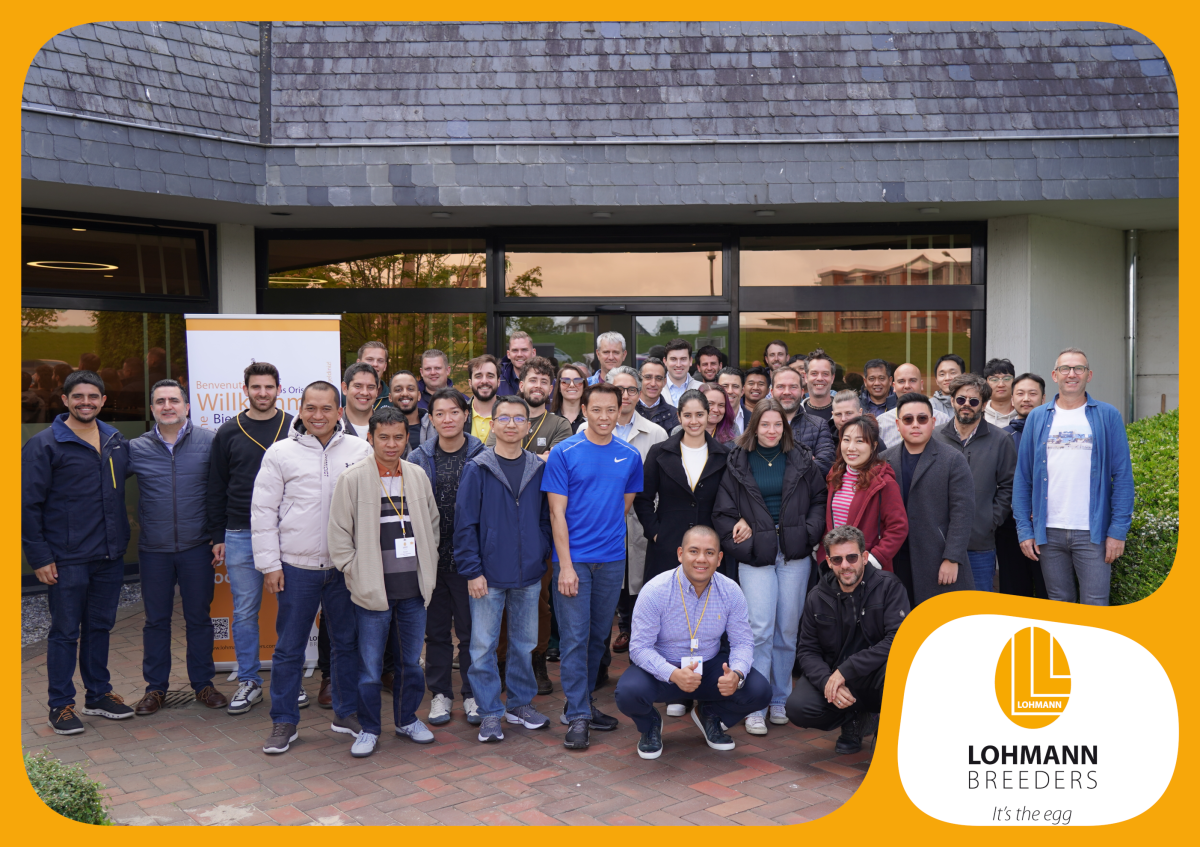Summary
Many people still suffer from iodine deficiency all over the world, but there is only a small range
between human requirements and upper levels (. 1 : 3). Therefore iodine belongs to the trace elements
of the Supply Category I (high risk of deficiency) and of the High Risk Category (high risk of excess).
Food of animal origin should contribute to improve the iodine supply to humans, but excesses have
to be avoided.
Some dose-response studies were carried out to assess the iodine transfer from feed into food of animal origin. Mainly the transfer from feed into meat is below 1 % of supplemented iodine, but it can be increased up to 30 % in the case of milk and eggs. In consequence of the high transfer, the EUcommission decreased the iodine-maximum level for dairy cows and laying hens from 10 to 5 mg kg-1 feed
More dose-response studies seem to be necessary with dairy cows and laying hens under consideration of the iodine supply of humans and the preventive consumer protection.
Some dose-response studies were carried out to assess the iodine transfer from feed into food of animal origin. Mainly the transfer from feed into meat is below 1 % of supplemented iodine, but it can be increased up to 30 % in the case of milk and eggs. In consequence of the high transfer, the EUcommission decreased the iodine-maximum level for dairy cows and laying hens from 10 to 5 mg kg-1 feed
More dose-response studies seem to be necessary with dairy cows and laying hens under consideration of the iodine supply of humans and the preventive consumer protection.
Introduction
Iodine is an essential trace element for humans and animals. More than 95 % of total iodine is accumulated in the thyroid gland. The only known roles of iodine in metabolism are its incorporation into the thyroid hormones, thyroxine (T4) and triiodothyronine (T3), and into the precursor iodotyrosines. Both hormones have multiple functions in the energy metabolism of cells, in the growth, as a transmitter of nervous stimuli, and as an important factor in brain development (Mc Dowell, 2003; Underwood and Suttle, 2001). Iodine deficiency reduces the production of thyroid hormones in humans and animals, leading to morphological and functional changes of the thyroid gland and reduction of the formation of thyroxin (ICCIDD, 2001). A high proportion of the population in Western and Central Europe is still at risk of iodine deficiency (Delange, 2002; Vitti et al., 2003; Delange and Dunn, 2004). Globally about 800 Mio people still suffer from iodine deficiency. Therefore improvement of iodine supply is still a great challenge for nutritionists (Lauerberg, 2004).Numerous measures have, therefore, been undertaken to improve the iodine supply to human diets, e.g., using iodized salts (e.g., Lind et al., 2002; Zimmermann, 2004), other vehicles for iodine (e.g., Dunn, 2003) supplementation of foods of plant or animal origin (e.g. Schöne et al., 2003; Zimmermann et al., 2005), or supplementing iodine to animal feed in order to increase the iodine content of food of animal origin (e.g., Kaufmann and Rambeck, 1998; Flachowsky et al., 2006; Schöne et al., 2006).
During the last few years, the status of iodine nutrition in some European countries has improved (Lind et al., 2002, Thamm et al. 2007) thanks to the use of various possibilities of adding iodine to human diets. But there are still problems with the contributions of various iodine sources.
Iodine requirements of food producing animals
The iodine requirements of food producing animals vary between 0.15 and 0.6 mg/kg dry matter (DM) of feed according to various scientific committees (Table 1).Table 1: Iodine requirements of food producing animals by the German Society of Nutrition
Physiology (GfE) and the National Research Council in the USA (NRC in mg/kg DM)
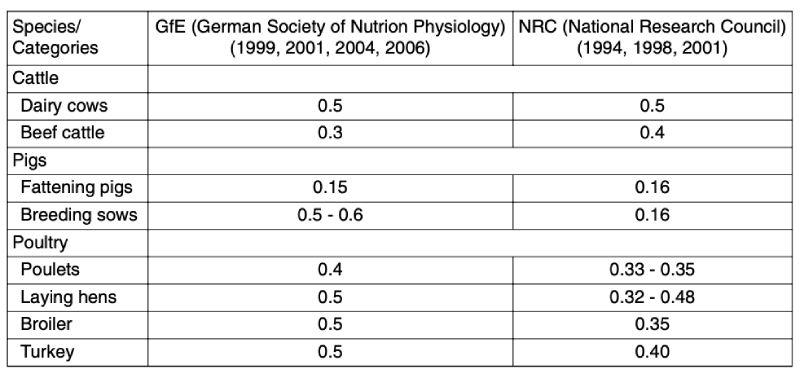
Human needs and upper levels
The iodine requirements of humans depend on age, physiological stage and scientific committee (Table 2).Table 2: Iodine requirements of humans depending on age, physiological stage and scientific
committee (in µg per day)
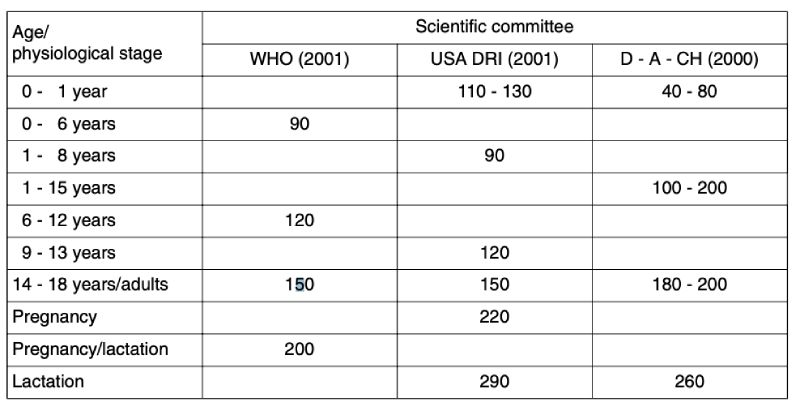
It increases from 50-100 to 200 µg and more per day. Pregnancy and lactation require more iodine. The iodine concentration in human food (. 0.4 – 0.5 mg/kg DM) is adequate to animal requirements under consideration of DM-intake of humans (compare Tables 1 and 2). There is a considerable variation in the tolerable upper levels of iodine intake of healthy humans (Table 3).
Table 3: Tolerable upper levels (UL) of iodine intake of healthy humans depending on age,
physiological stage and scientific committee (in µg per day)
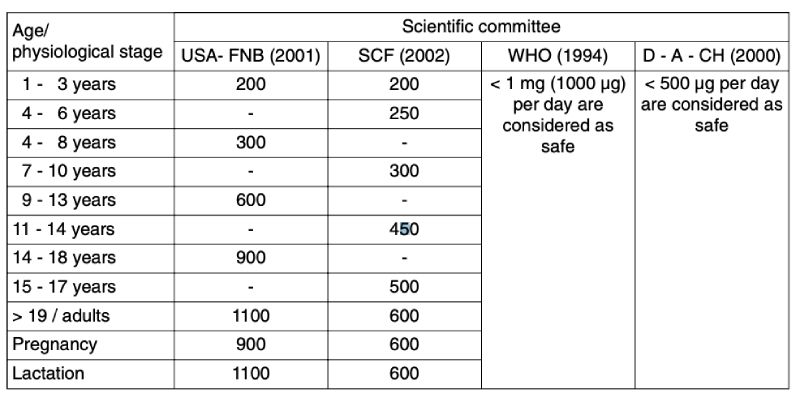
Iodine is characterized by a high risk of deficiency in human nutrition (Delange 2002, Delange and Dunn, 2004), but there is a low difference between requirements (Table 2, . 200 µg/day for adults) and the UL (Table 3, . 600 µg/day, SCF 2002).
That means the range between requirements and UL is only about 1 : 3. Therefore iodine belongs to the trace elements of the Supply Category I (high risk of deficiency from the global view) and of the High Risk Category (high risk of excess; BfR, 2004; EFSA, 2006; Gassmann 2006). Therefore, more information is necessary to avoid deficiencies and to prevent iodine excess in human nutrition.
Objectives of the report
Recently the EFSA (2005) dealt with this problem, esp. with the use of iodine in animal nutrition and with the transfer from feed into food of animal origin. The following conclusions were given:- More dose-response studies with food producing animals are necessary,
- Iodine requirements of modern breeds of animals should be revised,
- Assessment of further iodine inputs in food of animal origin is recommended.
Dose-Response-Studies
Some dose-response-studies with food producing animals were carried out at the Institute of Animal Nutrition of the FAL during the last few years, further studies are still underway. Iodine in feed, body samples, milk and eggs were analysed by ICP-MS.The paper informs about results from studies with dairy cows, growing bulls and growing pigs.
Dairy cows
In a preliminary test a grass – maize silage concentrate ration (0.2 mg I/kg DM) was supplemented with 0, 1, 4 or 10 mg I/kg DM and fed to five late lactating cows over 14 days (average milk yield: 22.1 ± 2.0 kg/day).Figure 1 shows the dramatic increase of iodine concentration in milk.
Figure 1: Iodine concentration of milk (µg/kg) depending on the iodine concentration of feed
(5 cows, 14 days of treatment; Flachowsky et al., 2006)
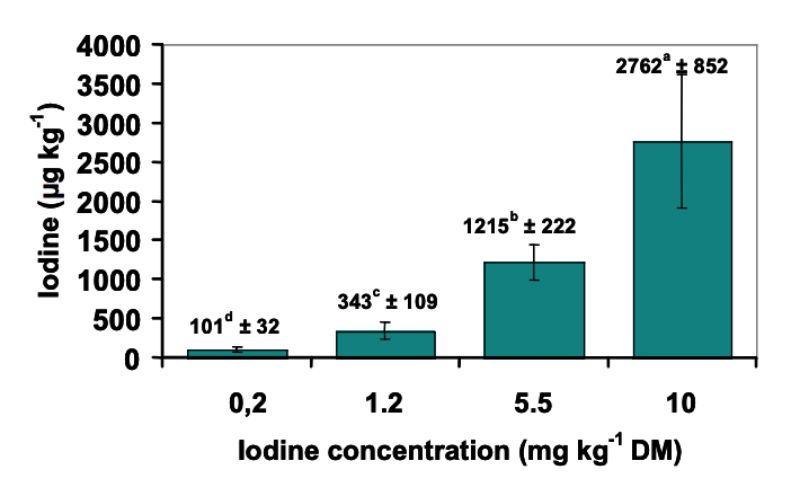
Beef cattle
A dose-response-study was carried out with 34 growing bulls of the German-Friesian breed (223-550 kg BW). The bulls consumed 3 kg concentrate per day and maize silage ad libitum. The bulls were divided into three groups and the diets were supplemented with 0.5, 4 and 10 mg/kg DM (11/11/12 bulls per treatment). At the end of the study, all bulls were slaughtered and the iodine concentration in some body samples was analysed.Iodine did not significantly influence the weight gain of bulls, but the daily weight gain of the most highly supplemented animal was 110 g lower than those of the control group (Table 4). Apart from the thyroid, the weights of body samples were not significantly influenced by iodine supplementation.
Table 4: Influence of iodine supplementation on selected live and carcass traits of bulls
(fattened from 223 to 550 kg) and the iodine content in various body samples
(n = 11/11/12; Meyer et al., 2007)
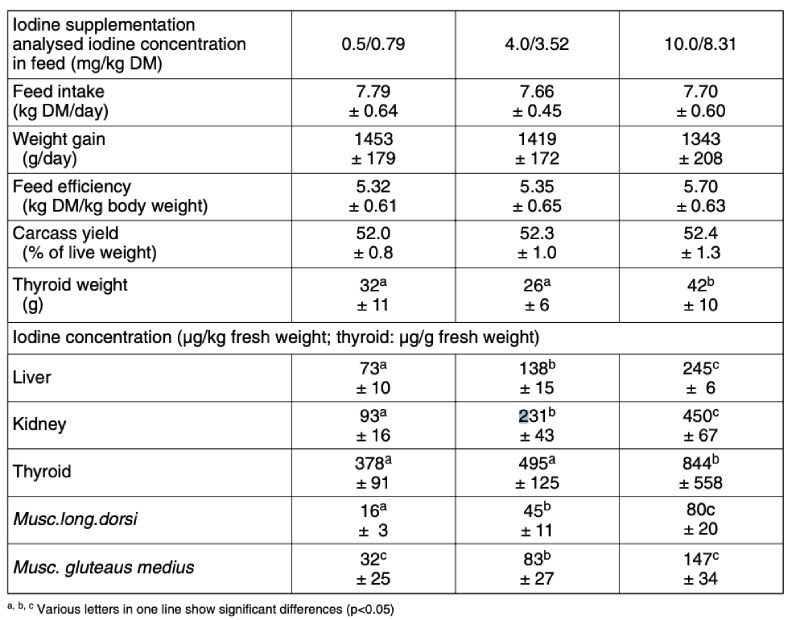
Iodine concentration in organs and tissue samples increased significantly with iodine supplementation (Table 4), but much less than in milk (see Figure 1).
Fattening pigs
70 growing pigs were divided into 5 groups and supplemented with 0, 0.5, 1, 2 and 5 mg iodine per kg dry feed. All pigs were slaughtered with a final weight of 120 kg. The native iodine content of feed amounted to 0.17 mg/kg, which is in accordance with the present iodine requirements of growing pigs (Table 1). Iodine supplementations did not influence (p >0.05) feed intake and weight gain of pigs (Table 5).Table 5: Influence of iodine supplementation on pigs fattened from 27 to 120 kg (n = 14;
Berk et al., 2004)
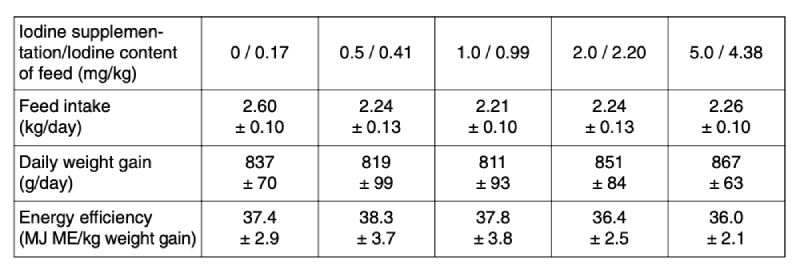
The iodine concentration in all body samples increased significantly after iodine supplementation (Table 6), but the concentration was much lower than in milk (see Figure 1).
Table 6: Influence of iodine supplementation on iodine content in various body samples
(n = 4; Franke et al., 2006)
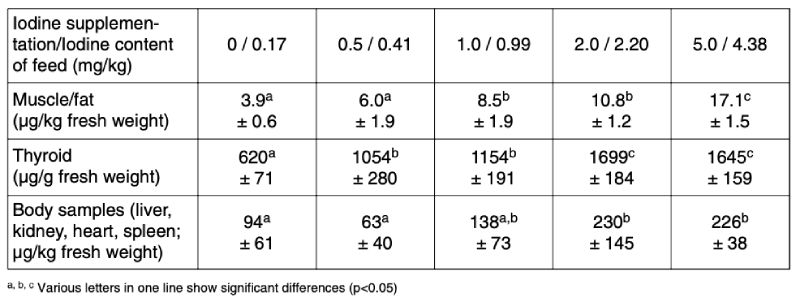
Iodine transfer
These results demonstrate that there are large differences in transfer of iodine from feed into pork (. 0.3 %) and beef (< 1 %) compared to milk from dairy cows (30-40 %) on the other hand. Iodine transfer from feed into eggs is also much higher (10 – 20 %) than from feed into meat as shown by dose-response-studies by Richter (1995) and Yalcin et al. (2004).Based on the differences in transfer, large differences also exist in the iodine concentration of various food of animal origin (Table 7).
Especially the iodine concentration in milk and eggs of low supplemented animals is much higher (Table 7) than values given in the present food tables (Table 8). Also results from field studies (Table 10 to 14) show higher iodine concentrations than the food tables (Table 8).
Table 7: Iodine content in food of animal origin (µg/kg fresh matter) depending on iodine
supplementation in feed

Table 8: Iodine content in food of animal origin according to food value tables
(Souci et al., 2000)

Iodine entry in milk via teat dipping of cows
Five late-lactating cows of the German Friesian breed were used for the study. The iodine content of the diet amounted to 0.2 mg/kg DM. After milking in the morning and evening, the teats were dipped in a teat disinfection solution containing Nonoxinol (9)-Iodine with 3 g available iodine per kg. Teat dipping with the disinfectant significantly increased the iodine concentration of milk (Figure 2), which is in agreement with other authors (Table 9).Figure 2: Iodine concentration of milk without and with teat dipping (iodine content of dipping
substances: 3 g I-1, dipping after milking; Flachowsky et al., 2007)
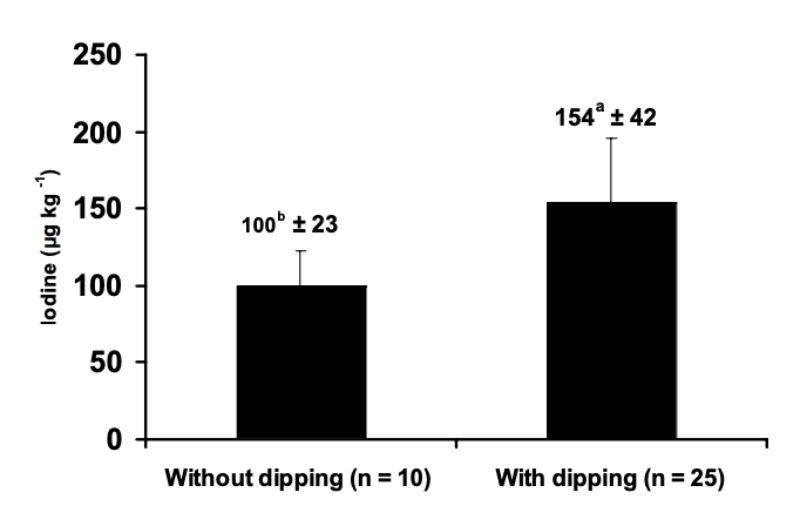
Table 9: Influence of teat dipping on iodine concentration in milk)
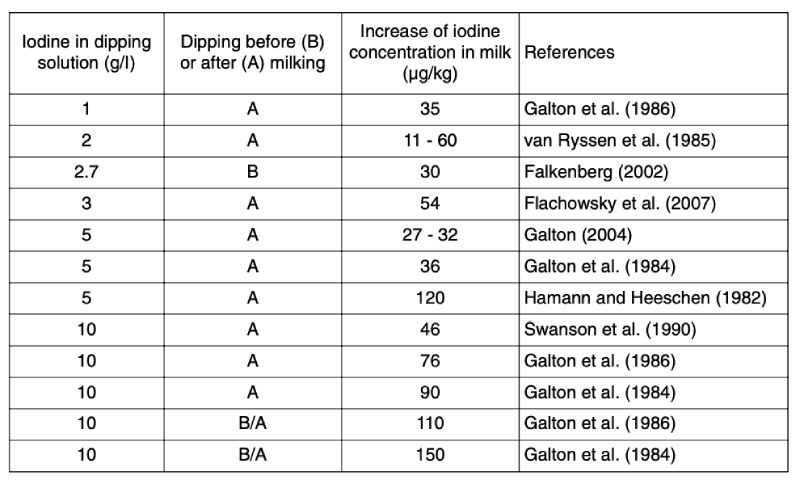
Three to five grams available iodine per litre disinfectant, and dipping after milking, increase the iodine content in milk by 50-60 µg per litre and contribute to the iodine supply of humans.
Field measurements
Apart from the dose-response-studies there some field measurements also exist on the iodine concentration in milk (Tables 10 and 11), poultry meat (Table 12) and eggs (Tables 13 and 14).Milk
The iodine concentration in milk increased in many European countries during the last few years (Table 10).Milk contains more than 100 µg/l in many countries (Table 11), exceeding 300 µg/l in England and the Czech Republic.
Such high concentrations could be a real problem under consideration of human needs (Table 2) and upper levels (Table 3), esp. for children.
Table 10: Iodine content in milk from various field samples
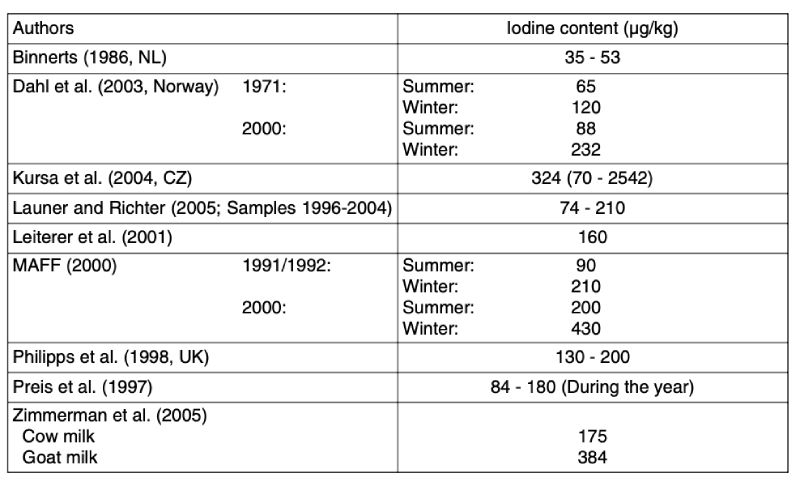
Table 11: Iodine concentration in milk in various European countries (Ryšava et al., 2007)
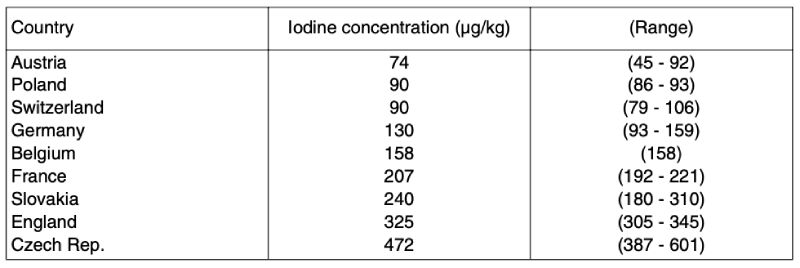
Poultry meat
The iodine concentration of poultry meat is relatively low (Table 12) and comparable with pork. Previous data by Groppel et al. (1991) show higher values, but on the basis of DM.Table 12: Iodine content of poultry meat by various authors
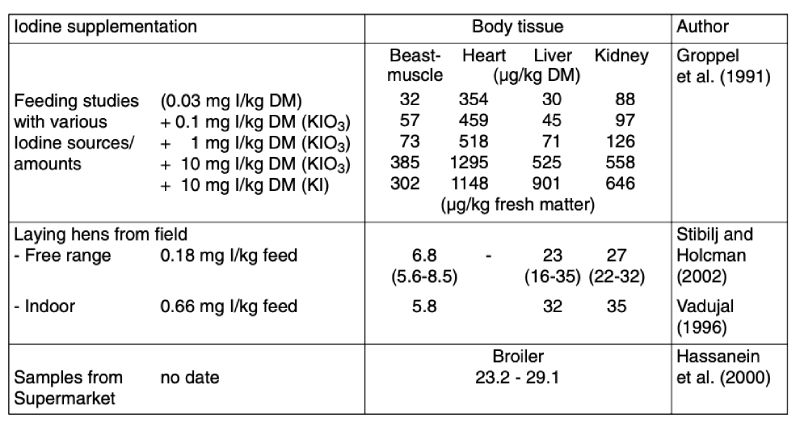
Eggs
Table 13: Iodine content in egg albumen and egg yolk from field samplesTable 13: Iodine content in egg albumen and egg yolk from field samples

The iodine concentration in egg yolk is much higher than in albumen (e.g. 856 and 16.2 µg/kg; Travnicek et al., 2006, Table 13).
Assuming that the egg yolk weight is 18 g and the albumen weight is 34 g, one egg produced in large flocks in the Czech Republic (see Table 14) contained 31.2 µg (. 15 %) and in small flocks about 10 µg iodine (. 5 % of iodine requirements of adults, see Table 2).
Feed supplementation
Based on previous results and the preventive consumer protection, the iodine upper level in feedingstuffs for dairy cows and laying hens was reduced from 10 to 5 mg per kg in 2005 (EU 2005)Table 14: Iodine content in the yolk of eggs from large and small flocks in the Czech Rep.
(Travnicek et al., 2006)

Table 15: Iodine concentration in feeding stuffs for cattle, pigs and laying hens (field samples,
Grünewald et al., 2006)

10 mg iodine per kg feedingstuffs are still permitted for other food producing animals (fish: 20 mg). The upper limits are much higher than the present iodine supplementation of various feedingstuffs under farm conditions (Table 15). But nevertheless, there is an iodine supplementation on the average between 1 and 2 mg kg-1 dry matter. This iodine concentration in field samples (e.g., Tables 10, 11 and 14) responses to the iodine supplementation in comparison to previous values (Table 8) and is in agreement with data from dose-response studies (see Table 7).
Berk, A., Leiterer, M., Schöne, F., Zimmermann C. und Flachowsky, G. (2004): Auswirkungen einer unterschiedlichen Jodversorgung auf die Leistung von Mastschweinen und den Jodstatus der Schilddrüse. 22. Arbeitstagung, Mengenund Spurenelemente, 24./25. Sept. 2004, Jena, 1377-1383
BfR (Bundesinstitut für Risikobewertung) (2004): Teil I: Verwendung von Vitaminen in Lebensmitteln. Teil II: Verwendung von Mineralstoffen in Lebensmitteln. Toxikologische und ernährungsphysiologische Aspekte. BfR-Pressestelle, Berlin, BfR-Wissenschaft 03 und 04/2004
DACH (2000): Referenzwerte für die Nährstoffzufuhr. Deutsche Gesellschaft für Ernährung (DGE), Österreichische Gesellschaft für Ernährung (ÖGE), Schweizerische Gesellschaft für Ernährung (SGE), Schweizerische Vereinigung für Ernährung (SVE). Umschau Braus GmbH, Verlagsgesellschaft, Frankfurt a. Main, 1. Auflage, pp. 179-184
Dahl, L., Opsahl, J.A., Meltzer, H.M. and Julshamn, K. (2003): Iodine concentration in Norwegian milk and dairy products. Brit. J. Nutr. 90, 679-685
Delange, F. (2002): Iodine deficiency in Europe anno 2002. Thyroid International 5: 1-19
Delange, F. and Dunn, J.T.: Iodine Deficiency. In: Braverman, L.E. and Utiger, R.D. (eds.) (2004): The Thyroid. A fundamental and clinical text. Lippincott, Williams and Wilkins publ., Philadelphia, 731-744
Dunn, J.T. (2003): Iodine should be routinely added to complementary foods. J. Nutr. 133, 3008S-3010S
EFSA, European Food Safety Authority (2005): Opinion of the Scientific Panel on Additives and Products or Substances used in Animal Feed on the Request from the Commission on the use of Iodine in Feedingstuffs. (Question NoEFSAQ-2003-058) http://www.efsa.eu.int/ science/feedap/feedap opinions/808/iodine1.pdf (14.09.05), pp. 42
EFSA (2006): Tolerable upper intake levels for vitamins and minerals, Parma, 478 p.
EU: Verordnung (EG) Nr. 1459/2005 der Kommission zur Änderung der Bedingungen für die Zulassung der Spurenelemente. Amtsblatt der Europäischen Union, L 233/8-10 vom 09.09.2005
Falkenberg, U., Tenhagen, B.A., Forderung, D. and Heuwieser, W. (2002): Effect of predipping with an iodophor teat desinfectant on iodine content of milk. Milk Sci. Int. 57, 599-601
Flachowsky, G., Schöne, F. und Jahreis, G. (2006): Zur Jodanreicherung in Lebensmitteln tierischer Herkunft. Ernähr.- Umsch. 53, 17-21
Flachowsky, G., Schöne, F., Leiterer, M., Bemmann, D., Spolders, M. and Lebzien, P. (2007): Influence of an iodine depletion period and teat dipping on the iodine concentration in serum and milk of cows. J. Anim. Feed Sci. 16: 18-25
Franke, K., Schöne, F., Leiterer M. und Berk, A. (2006): Einfluss einer gestaffelten Jodversorgung auf den Jodgehalt von Organen und Geweben bei Schweinen. Proc. 9. Tagung Schweine- und Geflügelernährung, 28.-30.11.2006, Halle, 173- 175
Galton, D.M. (2004): Effects of an automatic postmilking teat dipping system on new intramammary infections and iodine in milk. J. Dairy Sci. 87, 225-231
Galton, D.M. and Petersson, L.G., Erb H.N. (1986): Milk iodine residues in herds practicing iodophors premilking teat disinfection. J. Dairy Sci. 69, 267-271
Galton, D.M., Petersson, L.G., Merrill, W.G., Bandler, D.K. and Shuster, D.E. (1984): Effects of premilking udder preparation on bacterial population, sediment and iodine residue in milk. J. Dairy Sci. 67, 2580-2589
Gassmann, B. (2006): Zum Festlegen von Höchst- und Mindestmengen an Vitaminen und Mineralstoffen in Lebensmitteln. Ernährungs-Umschau 53: 336-343
GfE (Gesellschaft für Ernährungsphysiologie) (1999): Empfehlungen zur Energie- und Nährstoffversorgung der Legehennen und Masthühner (Broiler). Nr. 7, DLG-Verlag, Frankfurt, 185 pp.
GfE (Gesellschaft für Ernährungsphysiologie) (2001): Empfehlungen zur Energie- und Nährstoffversorgung der Milchkühe und Aufzuchtrinder. Nr. 8, DLG-Verlag, Frankfurt, 136 pp.
GfE (Gesellschaft für Ernährungsphysiologie) (2004) Empfehlungen zur Energie- und Nährstoffversorgung von Mastputen. Proceedings Society Nutrition Physiology. 13: 199-233
GfE (Gesellschaft für Ernährungsphysiologie) (2006) Empfehlungen zur Energie- und Nährstoffversorgung von Schweinen. Nr. 10, DLG-Verlag, Frankfurt, 247 p.
Groppel, B., Rambeck, W.A. und Gropp, J. (1991): Jodanreicherung in Organen und Geweben von Mastküken nach Jodsupplementation des Futters. Proc. 11. Arbeitstagung Mengen- und Spurenelemente, 12/13.12.1991, Jena, 300-308
Grünewald, K.-H., Steuer, G. und Flachowsky, G. (2006): Praxiserhebungen zum Jodgehalt im Mischfutter. Proc. 9. Tagung Schweine- und Geflügelernährung, 28.-30.11.2006, Halle, 176-178
Hamann, J. and Heeschen W. (1982): On the iodine content of milk. Milchwissenschaft 37, 525-529
Hassanein, M., Anke, M. and Hussein, L. (2000): Determination of iodine content in traditional Egyptian foods before and after a salt iodination programme. Pol. J. Food Nutr. Sci. 9/50, 25-29
ICCIDD, Unicef, Who (2001): Assessment of iodine deficiency disorders and monitoring their elimination. 2nd Edition, Geneva, WHO Publication
Kaufmann, S., Rambeck W.A. (1998): Iodine supplementation in chicken, pig and cow feed. J. Anim. Physiol. Anim. Nutr. 80, 147-152
Kursa, J., Herzig, I., Trávnícek, J. and Kroupová V. (2004): The effect of higher iodine supply in cows in the Czech Republic on the iodine content in milk. In: M. Anke et al. (Editors). Macro and Trace Elements. 22. Workshop, Jena, Vol. 2. SchubertVerlag, Leipzig, 1. Auflage, pp. 1080-1086
Lauerberg, P. (2004) Victories and challenges in optimizing iodine intake. Thyroid 14, 589
Launer, P. and Richter, O. (2005): Investigations for iodine concentration in the blood serum of milk cows from Saxonia as well as in cow’1 milk and milk products (baby food), Berl. Mün. Tierärztl. Wochenschr. 118, 502-508
Leiterer, M., Truckenbrodt, D. and Franke, K. (2001): Determination of iodine species in milk using ion chromatographic separation and ICP-MS detection. Eur. Food Res. Technol. 213, 150-153
Lind, P., Kummig, G., Heinisch, M., Igerc, I., Mikosch, P., Gallowitsch, M.J., Kresnik, E., Gomez, I., Unterweger, O. and Aigner. H. (2002): Iodine supplementation in Austria: Methods and results. Thyroid 12, 903-907
Lindmark-Mansson,H., Fonde, R. and Pettersson, H.-E. (2003): Composition of Swedish dairy milk. Int. Dairy J. 13, 409- 425
MAFF. Ministry of Agriculture, Fisheries and Food (2000) Iodine in milk. Food Surveillance Sheet Number 198, www.food.gov.uk/science/surveillance/maffinfo/2000/maff-2000-198
McDowell, L.,R. (2003): Minerals in animal and human nutrition. Iodine2nd Ed., Elsevier, pp. 305-334
Meyer, U., Weigel, K., Schöne, F., Leiterer, M. and Flachowsky, G. (2007): Effect of dietary iodine on growth and iodine status of growing fattening bulls. Livestock Sci. (in press)
NRC (1994): Nutrient Requirements of Poultry: Ninth Revised Edition. Nat. Acad. Press, Washington, D.C.
NRC (1998): Nutrient Requirements of Swine. 10th Ed. Nat. Acad. Press, Washington, D.C.
NRC (2001): Nutrient Requirement in Dairy Cattle. 7th Ed., Nat. Acad. Press, Washington, D.C.
Preis, U., Alfaro Santos, C., Spitzer, A., Wallnöfer, P.R. (1997): Iodine content of Bavarian consumer milk. Z. Ernährungswiss. 36, 220-224
Richter, G. (1995): Einfluss der Jodversorgung der Legehennen auf den Jodgehalt im Ei. Proc. 15. Arbeitstagung Mengenund Spurenelemente, 8./9.12.1995, Jena, 457-464
Ryšava, L., Kubackova, J. und Stransky, M. (2007): Jod- und Selengehalte in der Milch aus 9 europäischen Ländern. Proc. Germ. Nutr. Soc. 10: 45-46
SCF, Scientific Committee on Food (2002): Opinion of the Scientific Committee on Food on the Tolerable Upper Intake level of Iodine
Schöne, F., Leiterer, M., Hartung, H., Kinast, C., Greiling, A., Böhm, U. and Jahreis, G. (2003): Trace elements and further nutrition-related constituents of milk and cheese. Milchwissenschaft 58, 486-490
Schöne, F., Zimmermann, Ch., Quanz, G., Richter, G. and Leiterer, M. (2006): A high dietary iodine increases thyroid iodine store and iodine concentration in blood serum but has little effect on muscle iodine content in pigs. Meat Science 72: 365-372
Souci, F.W., Fachmann, W. and Kraut, H. (2000): Food Consumption and Nutrition Tables. 6th rev. edn. Medpahrm, Scientific Publishers, Stuttgart, Germany.
Swanson, E.W., Miller, J.K., Mueller, F.J., Patton, C.S., Bacon, J.A. and Ramsey, N. (1990): Iodine in milk and meat of dairy cows fed different amounts of potassium iodide or ethylenediamine dihydroiodide. J. Dairy Sci. 73, 398-405
Thamm, M., Ellert, U., Thierfelder, W., Liesenkötter, K.-P. und Völzke, H. (2007): Jodversorgung in Deutschland. Ergebnisse des Jodmonitorrings im Kinder- und Jugendgesundheitssurvey (KiGGS). Bundesgesundheitsbl.-Gesundheitsforsch.- Gesundheitsschutz 50: 744-749
Travnicek, J., Kronpova, V., Herzig, I. and Kursa, J. (2006): Iodine content in consumer hen eggs. Vet. Med. 51: 93-100
Underwood E.J. and Suttle, N.F. (2001): Iodine, p.343-374. The mineral nutrition of livestock, 3rd ed. (reprinted with corrections). CAB International, Wallington, UK. PB ISBN 0 85199 557 8; 624 pp.
US Food and Nutrition Board IOM (2001): Dietary Ref. Intakes for Vitamin A, Vitamin K, Boron, Chromium, Copper, Iodine, Iron, Manganese, Molybdenum, Nickel, Silicon, Vanadium and Zinc. Washington D.C. Nat. Academy Press
Vadujal, R. (1996): Graduation dissertation, Ljubljana, Biotechn. Faculty, Zootechnical dept. , 78 p.
Van Ryssen, J.B., Malsen, Va S. And Van Blerk, J.G. (1985): The iodine content of fresh milk samples in Natal and the effect of iodophor teat dips on milk iodine content. J. S. Afr. Vet. Assn. 56, 181-185
Vitti, P., Delange, F., Pinchera, A., Zimmermann, M. and Dunn, J.T. (2003): Europe is iodine deficient. Lancet 361, 1226
WHO (1994): Iodine and health. Eliminating iodine deficiency disorders safely through salt iodization. WHO publ. Geneva
WHO, UNICEF, ICCIDD (2001): Assessment of the Iodine Deficiency Disorders and monitoring their elimination. Geneva: WHO-publ. WHO/NHD/01.1. 1-107 pp
Yalcin, S., Kahraman, Z., Yalcin, S., Yalcin, SS. and Dedeoglu, H.E. (2004): Effects of supplementary iodine on the performance and egg traits of laying hens. Brit. Poult. Sci. 45, 499-503
Zimmermann, M.B. (2004): Assessing iodine status and monitoring progress of iodized salt programs. J. Nutr. 134, 1673- 1677
Zimmermann, C., Leiterer, M., Engler, K., Jahreis, G. and Schöne, F. (2005): Iodine in Camembert: Effects of iosed salt and milk orogin – cow versus goat. Milchwissenschaft 60, 403-406
Zusammenfassung
Jod in der Tierernährung und Jodtransfer von Futter in Lebensmittel tierischer HerkunftWeltweit leiden immer noch viele Menschen an Jodmangel. Andererseits besteht jedoch eine geringe Spanne zwischen Jodbedarf des Menschen und möglichem Überschuss (. 1 : 3). Jod gehört deshalb zu den Spurenelementen der Versorgungskategorie I (hohes Risiko eines Defizits) und zur Risikokategorie Hoch (hohes Risiko eines Überschusses). Lebensmittel tierischer Herkunft sollen zur Verbesserung der Jodversorgung der Menschen beitragen; Überversorgungen sind jedoch zu vermeiden. Verschiedene Dosis-Wirkungs-Studien zur Beurteilung des Jodtransfers vom Futter in Lebensmittel tierischer Herkunft wurden durchgeführt. Dabei zeigte sich, dass der Transfer vom Futter in Fleisch bei unter 1 % liegt, während in Eier und vor allem in Milch bis zu 30 % des zugesetzten Jods übergehen können.
Unter Berücksichtigung dieses hohen Transfers hat die EU-Kommission die Jod-Höchstgehalte im Futter von Legehennen und Milchkühen von 10 auf 5 mg/kg Futter gesenkt. Weitere DosisWirkungsstudien mit Legehennen und Milchkühen sind vor allem unter dem Aspekt des vorbeugenden Verbraucherschutzes notwendig.





